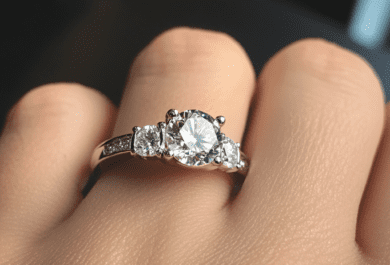Baguette Diamond – Basics
The long, elegant baguette diamond is a frequent choice for side stones, accentuating the piece’s center stone. While it has less facets than most center stone choices, that simplicity helps it remain versatile.
PriceScope Pointer: Most laboratories issue NO CUT GRADE for shapes other than round: If the cut is described as “Ideal” or “Excellent” (etc.) it’s a seller’s description, not a laboratory judgment.
Before going on: Check out the PriceScope Diamond Buying Guide
Baguette Diamonds Described
Among the various diamond shapes the baguette diamond is cousin to the emerald cut but has fewer facets. In fact, the traditional 14 facet baguette diamond is one of the most clean and simplest shapes. Like any rings featuring step cuts, baguette diamond rings will have different visual character than rings featuring brilliant cuts. The baguette diamond is a popular choices for accenting a featured stone, typically set horizontally, one baguette diamond per side.
With that said, one can create a baguette diamond ring like the creation seen below, featuring a central baguette diamond and tapered baguettes used as side stones.

The Fancy, Inconvenient Truth
Baguette diamonds may be cut for weight, at the expense of beauty. This is because many grading laboratories, including GIA, do not assess the optical performance of the baguette or other fancy shapes. With no standards enforced, manufacturers tend to plan for the highest yield possible, resulting in some baguette diamonds having considerably more depth than practical.
Exceptions
The AGS and GCAL assess and grade the optical performance of certain fancy shapes. If you’re seeking cut quality affirmation, fancy shapes with performance deficits will not earn the highest marks from those top-tier laboratories.
tips
Baguette Diamond Selection Tips
Length to Width Ratio:
Baguette diamonds are typically long and thin. The common ratio is around 5.1. With that said, the ratio depends on the application. Some baguette diamonds are nearly square in shape. There are also tapered baguettes, typically set so the narrow end is pointed away from the center of the ring.
Other Notes:
The step cutting style and large table on baguette diamonds leave few places for inclusions to hide. Color saturation is also more noticeable in a baguette diamond ring so those seeking clean, colorless appearing diamonds will want to gravitate towards H-VS2 and higher.
The baguette diamond faceting style also lends itself to highly visible inclusions. The prominent table facet and adjacent step cut facets are like having clear windows right into the center of the stone. Any dark inclusions in the middle of a baguette diamond will be clearly visible.
In other words, both color (when present) and inclusions (when present) will be more noticeable in a baguette diamond, due to its faceting style, than the same color and clarity would be in a round, princess or cushion cut diamond.
Fortunately, well cut baguette diamonds are great at maximizing carat weight. Any baguette diamond that is not overly deep, and within the recommended girdle thickness range reliably look larger from the “face up” position than princess cuts, radiant cuts, and round brilliants of the same carat weight.
Get fast answers to any question: Ask our community of unbiased independent helpers.
Ready to find your diamond?












